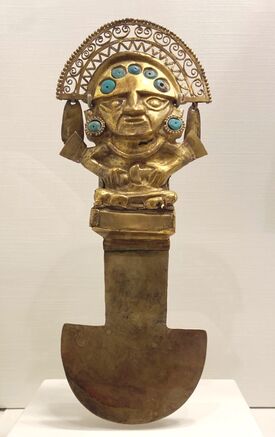Tumi
The Tumi or Ceremonial knife is a 10th or 11th century cultural artifact exhibited as part of the Pre-Columbian Collection at the Birmingham Museum of Art. It was made and used by the Sicán (also known as the Lambayeque) culture which occupied the Pacific coast of what is now the Lambayeque department of northern Perú from around 750 CE to 1375 CE.
The Quechua word "tumi" can be used for any sharp implement. The highly decorative metal knife with a characteristic semicircular blade and a depiction of the "Sicán Lord" in gold alloy and turquoise has been found in numerous burials. Similarly-shaped blades made of more functional materials and used by other cultures in the region, are thought to have been used for trepanation, ritual decapitation of captured enemies, and perhaps in human sacrifice. The iconic tumi shape also appeared on head ornaments, in "coins" used for trade, and in other objects. In modern times, the image of a Sicán tumi has come to be recognized as a national symbol of Perú, often appearing in tourism materials highlighting the nation's cultural wealth. Replica tumis are also commonly displayed in homes as a symbol of good luck.
The tumi displayed in Birmingham is 13 5/8" tall by 5 1/4" wife, and 1 1/4" thick at the thickest section. It was assembled by a highly-skilled artisan from numerous pieces of "tumbaga", an alloy containing god, copper and silver and decorated with inlaid turquoise. A range of stone hammers and other implements were used to form the figure from the back (repoussé). Soldering and mechanical joints were used to piece the tumi together.
Atop the tumi is the seated figure of a "Sicán Lord", sometimes identified as "Naylamp", a divine and historical personage which appears in a broad range of artifacts from the Sicán culture. The figure is depicted with typical attributes such as upturned comma-shaped eyes, large jeweled ear spools, and a filagreed headdress. In his left hand, the figure holds a tumi, apparently in the act of cutting an indeterminate object held in the right hand, which has been identified at different times as a head or a heart. It is likely that when the tumi was made, it would have appeared as polished gold, revealed by etching the other metals away from the surface of the alloy in a mild acid (depletion gilding).
Prior to the excavation of an intact burial complex in the Bosque de Pómac Historic Sanctuary in 1991–1992, no Sicán tumis had been studied in situ by archeologists. All known examples are presumed to have been acquired by tomb robbers who dug more than 100,000 pits and plowed hundreds of bulldozer trenches in the area from the 1930s through the 1970s. Many of the objects that reached the market for Pre-Columbian antiquities were misidentified as Incan artifacts, and many were damaged during excavation, or by attempts to clean or restore them for sale. The museum purchased its tumi in 1964.
A three-dimensional replica of the tumi has been used as part of the museum's "Sensory Empowerment Program" for visitors with low or no vision.
References
- Shimada, Izumi & Jo Ann Griffin (January 2005) "Precious Metal Objects of the Middle Sicán" Scientific American Special Editions, Vol. 15, No. 4, pp. 80-89
External link
- Ceremonial knife (tumi) at artsbma.org
